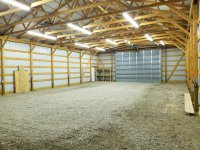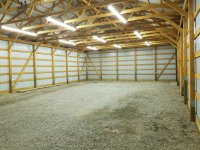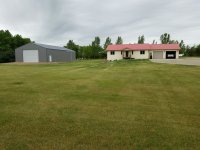Slowpoke Slim
Elite Member
- Joined
- Jan 6, 2017
- Messages
- 3,916
- Location
- Bismarck, ND
- Tractor
- Husqvarna YTH24V48 riding mower, Branson 3725CH
I didn't want to hijack an existing thread. This would be the "North Dakota" Edition... and yeah, it really does get to -40F here in winter (although not THIS winter for some reason).
I'm kicking around the idea of heating my new pole barn. We just moved in this past summer, bought an existing house with an existing pole barn, so still lots of things to square away at the new place. Lower on the list, but still there is looking at my 40x70x14' wall pole barn. It is new construction (~5 years), has power and lights (100 amp panel), but no insulation and no heat source. Also sadly, it is a gravel floor. I think it's crushed concrete. Mrs. Slim said at time of purchase that we could just have a concrete floor poured (lol, yeah ok Dear, whatever you say - wait until you find out how much THAT will cost ). Lets just say I doubt it ever gets concreted. Lets also just say that Mrs. Slim fell in love with this house immediately when she saw it, so this is where we live now. Call it a "compromise". Lol.
). Lets just say I doubt it ever gets concreted. Lets also just say that Mrs. Slim fell in love with this house immediately when she saw it, so this is where we live now. Call it a "compromise". Lol.
Anyway, first step to me would be to insulate the shell, probably just keep it simple and spray foam the entire inside (open rafters) and whatever R value we end up with is what we'll have. There is a roll up door at one end, 16'x14' high that I'll probably put foam panels on, and there's a barn-style sliding door at the other end that's probably 12'x14' high that I'll do the same. There's only one walk in door to access the building. When it's all closed up, it is surprisingly air tight. No roof vents to deal with.
The next biggest issue I will have is there is currently only electrical power on site for choice for heat source. We have no propane on site, house is all electric. It (the house) does have a geothermal system, with backup electric forced air furnace for supplemental heat, so the house is "good". We're out in the county, so no natural gas would ever be available. I don't really want to heat that large of air space (the shop) with electric heat, as in my mind that would be frightfully expensive. I think the cheapest option would either be a large double barrel (55 gal drum type) wood burning stove, or maybe a pellet stove. Maybe more than one pellet stove. That or bring in a propane tank and go with ceiling mounted propane fired furnace(s), or ceiling mounted radiant.
The goal wouldn't be to get the whole place up to "T-shirt temperature", but would like to be able to keep it above zero, or better yet, above freezing when I'm out there. Even if it's an area near to the heat source that I could still work around in when needed. I do have a heated and insulated oversized 2 car garage attached to the house that has my "shop" setup in it now. Tools, saws, large (220v) shop air compressor and reloading bench. But right now, that takes away one parking spot inside.
Right now the shop building is just being used for storage/parking. My 34' 5th wheel RV trailer (winterized), 18' flatbed car trailer, tractor + implements, riding mower, etc, are all parked out there. There's also plenty of spare room out there (for now, lol, I know shop space tends to evaporate over time). I wouldn't mind getting some of my space back in the attached garage though. Would be nice to park my truck inside a heated garage in winter time. Wife's car goes in the one side, but the other half of garage space is currently my "shop".
So kicking around ideas really. I've even thought about bringing in a smallish construction office trailer and parking it in the shop building on footings. That would give me another insulated area that would be easier to heat and keep warm, but how useful would that space really be vs. open shop area. I would probably keep my reloading shop in the garage, but wouldn't mind moving the rest out to the shop building eventually.
Not in a hurry for any of this, wife has informed me that this is our "last house". Lol. But pondering these things gives me stuff to do this winter. So far there's no snow to move, and nothing to mow, so lots of spare time to "ponder things".
Thoughts?



These are from closing, the day we got the keys. The shop has more "stuff" in it now. Lol.
I'm kicking around the idea of heating my new pole barn. We just moved in this past summer, bought an existing house with an existing pole barn, so still lots of things to square away at the new place. Lower on the list, but still there is looking at my 40x70x14' wall pole barn. It is new construction (~5 years), has power and lights (100 amp panel), but no insulation and no heat source. Also sadly, it is a gravel floor. I think it's crushed concrete. Mrs. Slim said at time of purchase that we could just have a concrete floor poured (lol, yeah ok Dear, whatever you say - wait until you find out how much THAT will cost
Anyway, first step to me would be to insulate the shell, probably just keep it simple and spray foam the entire inside (open rafters) and whatever R value we end up with is what we'll have. There is a roll up door at one end, 16'x14' high that I'll probably put foam panels on, and there's a barn-style sliding door at the other end that's probably 12'x14' high that I'll do the same. There's only one walk in door to access the building. When it's all closed up, it is surprisingly air tight. No roof vents to deal with.
The next biggest issue I will have is there is currently only electrical power on site for choice for heat source. We have no propane on site, house is all electric. It (the house) does have a geothermal system, with backup electric forced air furnace for supplemental heat, so the house is "good". We're out in the county, so no natural gas would ever be available. I don't really want to heat that large of air space (the shop) with electric heat, as in my mind that would be frightfully expensive. I think the cheapest option would either be a large double barrel (55 gal drum type) wood burning stove, or maybe a pellet stove. Maybe more than one pellet stove. That or bring in a propane tank and go with ceiling mounted propane fired furnace(s), or ceiling mounted radiant.
The goal wouldn't be to get the whole place up to "T-shirt temperature", but would like to be able to keep it above zero, or better yet, above freezing when I'm out there. Even if it's an area near to the heat source that I could still work around in when needed. I do have a heated and insulated oversized 2 car garage attached to the house that has my "shop" setup in it now. Tools, saws, large (220v) shop air compressor and reloading bench. But right now, that takes away one parking spot inside.
Right now the shop building is just being used for storage/parking. My 34' 5th wheel RV trailer (winterized), 18' flatbed car trailer, tractor + implements, riding mower, etc, are all parked out there. There's also plenty of spare room out there (for now, lol, I know shop space tends to evaporate over time). I wouldn't mind getting some of my space back in the attached garage though. Would be nice to park my truck inside a heated garage in winter time. Wife's car goes in the one side, but the other half of garage space is currently my "shop".
So kicking around ideas really. I've even thought about bringing in a smallish construction office trailer and parking it in the shop building on footings. That would give me another insulated area that would be easier to heat and keep warm, but how useful would that space really be vs. open shop area. I would probably keep my reloading shop in the garage, but wouldn't mind moving the rest out to the shop building eventually.
Not in a hurry for any of this, wife has informed me that this is our "last house". Lol. But pondering these things gives me stuff to do this winter. So far there's no snow to move, and nothing to mow, so lots of spare time to "ponder things".
Thoughts?



These are from closing, the day we got the keys. The shop has more "stuff" in it now. Lol.